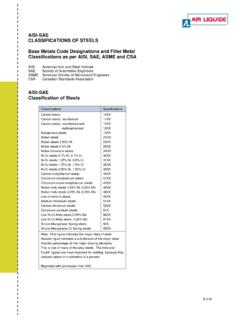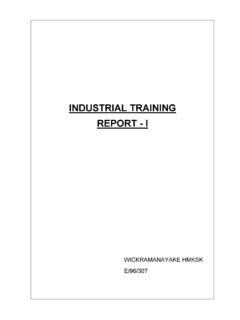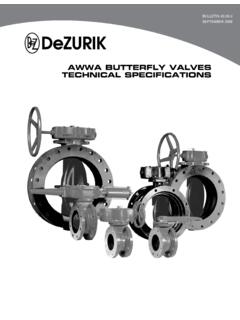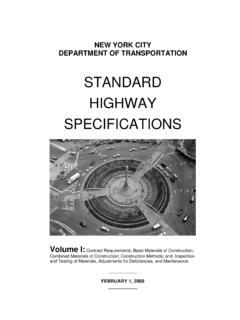Transcription of Iron Classification Codes and Characteristics
1 2006 CASTING SOURCE DIRECTORY ENGINEERED CASTING SOLUTIONS 17 This gray iron manifold for wheel loaders was developed by the casting supplier and cus-tomer from concept-to-casting in less than one month. The new design cut the processing time of the component in AlloysTable 1. Composition Range for Un-Alloyed Cast IronsIron Family Carbon Silicon Manganese Sulfur PhosphorusGray iron castings are produced by a variety of molding methods and are available with a wide range of properties. Cast iron is a generic term that designates a family of metals. To achieve the best casting for a particular application at the lowest cost consistent with the component s require-ments, it is necessary to have an under-standing of the six types of cast iron : gray iron ; ductile iron ; compacted graphite iron (CGI); malleable iron ; white iron ; alloyed 1 lists the typical composition ranges for common elements in fi ve of the six generic types of cast iron .
2 The Classification for alloyed irons has a wide range of base compositions with major additions of other elements, such as nickel, chromium, molybdenum or copper. The basic strength and hardness of all iron alloys is provided by the metallic structures containing graphite. The prop-erties of the iron matrix can range from those of soft, low-carbon steel (18 ksi/124 MPa) to those of hardened, high-carbon steel (230 ksi/1,586 MPa). The modulus of elasticity varies with the class of iron , Joseph S. Santner, American Foundry Society, Schaumburg, IllinoisGeorge M. Goodrich, Professional Metallurgical Services, Buchanan, Michiganshape (sphericity) and volume fraction of the graphite phase (percent free carbon).Because of their relatively high sili-con content, cast irons inherently resist oxidation and corrosion by developing a tightly adhering oxide and subscale to repel further attack.
3 iron castings are used in applications where this resistance provides long life. Resistance to heat, oxidation and corrosion are appreciably enhanced with alloyed of the cast iron family can be adjusted over a wide range and enhanced by heat treatment. Annealing readily produces a matrix of soft machin-able ferrite. In limited situations, this annealing can be accomplished at sub-critical temperatures. Heating above this critical temperature takes the carbon from the graphite and places it in the matrix. This engineered material can be through-hardened and tem-pered using conventional heat treat-ing or surface hardening. These adjust-ments create the cast iron family. Gray iron Flake graphite provides gray iron with unique properties (such as excellent machinability) at hardness levels that produce superior wear-resistant Characteristics , the ability to resist galling and excellent vibration iron An unusual combina-tion of properties is obtained in ductile iron because the graphite occurs as spher-oids rather than as fl akes.
4 The different Pictured is a dual de-livery seed and fertilizer tool for use in the agricul-tural industry. The sand cast component features a ductile iron knife body and a high-chrome ENGINEERED CASTING SOLUTIONS 2006 CASTING SOURCE DIRECTORYT able 2. iron Specifi cations, Characteristics & Applications Gray iron Standard Specifi cations Characteristics Applications ASTM A48: gray iron castings ASTM A74: cast iron soil & pipe fi ttings ASTM A126: gray iron castings for valves, fl anges & pipe fi ttings ASTM A159: automotive gray iron castings SAE J431: automotive gray iron castings ASTM A278 & ASME SA278: gray iron castings for pressure-containing parts for temperatures up to 650F (343C) ASTM A319: gray iron castings for elevated temperatures for non-pressure-containing parts ASTM A823: statically cast permanent mold castings ASTM A834.
5 Common requirements for iron castings for general industrial use Several strength grades; vibration damping; low rate of thermal expansion & resistance to thermal fatigue; lubrication retention; and good engine blocks manifolds for internal combustion engines; gas burners; machine tool bases; dimensionally stable tooling sub-jected to temperature variations, such as gear blanks & forming die covers; cylinder liners for internal combustion engines; intake manifolds; soil pipes; counterweights; and enclosures & housings. Ductile iron Standard Specifi cations Characteristics Applications ASTM A395 & ASME SA395: ferritic ductile iron pressure-retaining castings for use at elevated temperatures ASTM A439: austenitic ductile iron castings ASTM A476 & ASME SA476: ductile iron castings for paper mill dryer rolls ASTM A536 & SAE J434: ductile iron castings ASTM A571 & ASME SA571: austenitic ductile iron castings for pressure-containing parts suitable for low-temperature service ASTM A874: ferritic ductile iron castings suitable for low-temperature service ASTM A897: austempered ductile iron castingsSeveral grades for both strength & ductility; high strength, ductility & wear resistance; contact fatigue resistance.
6 Ability to withstand thermal cycling; and production of fracture-critical components. Steering knuckles; plow shares; gears; automotive & truck suspension components; brake components; valves; pumps; linkages; hydraulic components; and wind turbine Standard Specifi cations Characteristics Applications ASTM A842: CGI castingsA compromise of properties between gray & ductile engine blocks cylinder liners; brake discs for trains; power generators; exhaust manifolds; pump housings; and brackets. Standard Specifi cations Characteristics Applications ASTM A532: abrasion-resistant white iron castingsExtremely hard & & grinding applications; and grinding IronMalleable iron Standard Specifi cations Characteristics Applications ASTM A47 & ASME SA47: ferritic malleable iron castings ASTM A197: cupola malleable iron ASTM A220: pearlitic malleable iron ASTM A338: malleable iron fl anges, pipe fi ttings & valve parts for railroad, marine & other heavy-duty service up to 650F (343C) ASTM A602 & SAE J158: automotive malleable iron castingsSoft & extremely ; sprockets; tool parts & hardware; connecting rods; drive train & axle components; and spring suspensions.
7 AlloyedIron Standard Specifi cations Characteristics Applications ASTM A436: austenitic gray iron castings ASTM A518: corrosion-resistant high-silicon iron castingsCorrosion resistant; retains strength & dimensions during elevated-temperature exposure; and ability to withstand thermal cycling. grades are produced by controlling the matrix structure around the graphite either as-cast or by heat treatment. Only minor compositional differences (to pro-mote the desired matrix microstructure) exist among the regular grades. Alloy additions may be made to assist in con-trolling the matrix structure as-cast or to provide response to heat treatment. The high-strength grades can be quenched and tempered to form a bainite-like matrix produced by austempering.
8 Austempered ductile iron (ADI) provides twice the strength of conventional ductile iron at a given level of ductility. ADI can have strength in excess of 230 ksi (1,586 MPa); however, its modulus is 20% lower than steel with a comparable Graphite iron (CGI) In CGI, graphite locally occurs as intercon-nected blunt fl akes. This graphite structure Parts for chemical processing plants; petroleum refi ning; food handling & marine service; control of corrosive fl uids; and pressure valves. 2006 CASTING SOURCE DIRECTORY ENGINEERED CASTING SOLUTIONS 19 Table 3. Property Comparisons for Gray iron ClassesProperty Class 25 Class 30 Class 30 Class 35 Class 40 (as-cast) (as-cast) (annealed) (as-cast) (as-cast)Brinell Hardness 187 207 109 212 235 Tensile Strength ksi (206 MPa) ksi (232 MPa) ksi (142 MPa) ksi (240 MPa) ksi (289 MPa)Modulus of Elasticity Msi (114 GPa) Msi (117 GPa) Msi (100 GPa) Msi (124 GPa) Msi (126 GPa)
9 Tensile Poisson s Ratio Poisson s Ratio Strength Ratio and the resulting properties are interme-diate between gray and ductile irons. The compacted graphite shape also is called quasi-fl ake, aggregated fl ake, semi-nodular and vermicular iron White iron is hard and essentially free of graphite. The metal so-lidifi es with a compound called cementite, which is a phase that dominates the mi-crostructure and properties of white iron . The carbides are in a matrix that may be pearlitic, ferritic, austenitic, martensitic or any combination iron In malleable iron , the graphite occurs as irregularly shaped nodules called temper carbon because it is formed in the solid state during heat treatment.
10 The iron is cast as a white iron of a suitable chemical composi-tion to respond to the malleabilizing heat treatment. Alloyed iron This Classification includes gray irons, ductile irons and white irons that have more than 3% alloying elements (nickel, chromium, molybde-num, silicon or copper). malleable irons are not heavily alloyed because many of the alloying elements interfere with the graphite-forming process that occurs dur-ing heat treatment. Specifi cation SourcesThere are a number of standard speci-fi cations for several cast iron products, such as pipes and fi ttings. But due to the important infl uence of the individual de-sign on the Characteristics of a casting, re-quirements (actual strength, dimensional tolerances and surface fi nish) cannot be stated in a general specifi cation.




